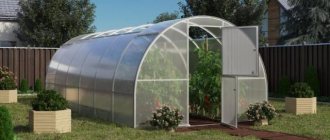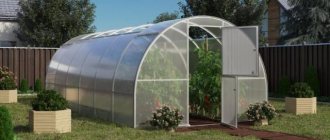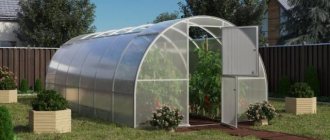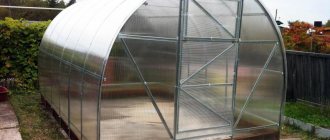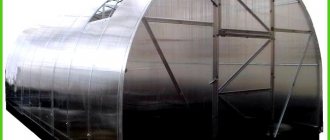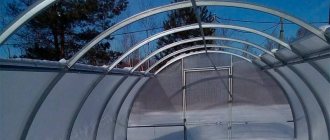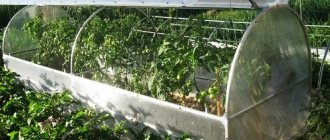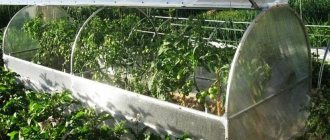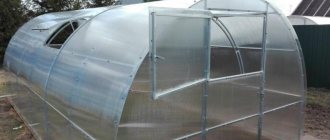Traditional greenhouses with closed sides, making it difficult to approach plants, and welded prefabricated arches, reducing resistance to loads, are being replaced by more reliable structures. Summer residents prefer durable products. The Tulip greenhouse with an opening roof and sides does not collapse under the weight of snow, allows you to conveniently approach the plants and get a rich harvest.
Features of the Tulip greenhouse
The new design of the Tulip greenhouse with a sliding roof and sides has a number of advantages along with the traditional ones:
- reinforced “anti-storm” guide arc system;
- simplified assembly using a four-bolt “crab” system;
- reliable frame made of all-welded arcs;
- Attached is a video instruction for assembling the Tulip greenhouse;
- sheets do not stick when condensation accumulates;
- the opening mechanism of the roof and sides is equipped with rubber seals;
- polycarbonate is mounted in guide arcs;
- no foundation required;
- the opening roof and sides are resistant to wind and snow loads;
- Warranty period up to 15 years.
DIY arched greenhouse
One of the simplest, inexpensive designs, it heats the soil for sowing and protects plants from frost in spring and autumn. It is assembled from support arcs, pins, and covering material. You can make formwork from boards or use guide reinforcement.
Arcs are made of rigid wire or PVC pipes with a diameter of 15-25 mm. The pipes are bent into the desired shape, then placed on reinforcement rods previously driven into the ground. You can also secure the pipes using staples. The wire arches are secured with U-shaped pins. The design can be of any size.
Before starting work, it is better to make a drawing on paper and calculate the amount of materials needed. For a greenhouse 90 cm wide, arcs of 1.8-2 m are needed, they are placed at a distance of about 60-80 cm from each other. After installing the arches, they are covered with durable plastic film. It is attached to the arches using special clips; you can also sew special pockets on the covering material and put the coating on the pipes.
Step-by-step video instructions
Advantages and disadvantages
Advantages of the Tulip greenhouse with opening top:
- galvanized solid-bent arches increase the reliability of the structure;
- the opening roof mechanism eliminates snow loads;
- natural microclimate increases productivity;
- the opening roof and sides allow the greenhouse to be watered with rain, which enriches the earth with minerals;
- the opening mechanism of the sides promotes natural air exchange - plants receive the necessary dose of oxygen every day without drafts;
- opening sides allow you to conveniently approach each plant;
- the opening top will help fill the greenhouse with snow, this protects the soil from freezing and preserves its microflora;
- the guides are made of galvanized profile and equipped with a rubber seal at the points of contact with polycarbonate;
- opening sides and roof promote natural pollination of crops;
- The warranty period has been extended to 15 years.
Flaws:
- when installed without a foundation, severe distortion of the structure is possible;
- it is difficult to mount the opening element of the sides and roof to the arches;
- plastic parts lose elasticity in the cold, forming gaps between the frame and the guides of the opening mechanism;
- the manufacturer is located in Belarus, which complicates the supply of spare parts, since Russian distributors do not sell them;
- The crab system becomes loose during operation.
Do-it-yourself greenhouse “breadbox”
This design got its name because of the mechanism for opening the upper part. The product looks stylish, brings not only benefits and an early harvest, but also becomes a decoration for the dacha. Consists of a frame, sides, roof. A favorable microclimate is created thanks to the arched shape.
Like other greenhouses, the “breadbox” can be made in various sizes, it all depends on the available space. Usually they are made no more than 4 m long, otherwise special mechanisms will be needed to raise the roof. The height is selected according to your own height. The higher, the heavier the product, the classic height is 0.5-1.3 m. The width with one opening door is no more than 1.3 m.
Manufacturing requires special skills and tools. If you want to make a metal frame, use pipes with a thickness of 1.5-3 mm. Polycarbonate or thick spunbond film is used as a covering material for making a greenhouse with your own hands. This design requires a preliminary drawing and calculation of the required material.
First, the lower frame is assembled, the legs can be omitted, then the sidewalls are attached to it. The arches are bent using a pipe bender and fastened at a distance of half a meter from each other. The arcs are made so that they do not interfere with each other and are joined at an angle of 900C.
To open the lid, a special hinge mechanism is installed. Holes for the hinges are made on the outside. Welding seams are well cleaned, the structure is painted with a special paint that protects the product from rust and environmental influences.
The polycarbonate is pre-cut and attached to the frame, first in the corners, then in the middle. The plants that feel most comfortable in such a greenhouse are lettuce, green onions, parsley, carrots, pomegranate, low-growing tomatoes and other low-growing crops.
What can be grown in a Tulip greenhouse
One of the advantages of greenhouses with opening tops and sides is their versatility. Such greenhouses are perfect for growing fruits, vegetables and flowers. Often, a greenhouse is used to force tulips in early spring.
The structure is suitable for breeders. The innovative design allows you to freely approach plants and carry out the necessary experiments on them.
Design characteristics
New for 2022, the Tulip greenhouse with opening sides and a sliding roof is made from a closed galvanized pipe 40*20 mm. The ends of the structure are equipped with wide doors with built-in windows. A 1 m wide door connector allows you to bring a wheelbarrow into the greenhouse.
Important! The arcs are made of all-welded pipe. This increases the rigidity and stability of the structure.
Dimensions
The manufacturer produces a product with a width of 3 m, a height of 2.1 m, and a length of 4, 6, 8, 10 m. The length of the greenhouse can be increased at the customer’s request in increments of 2 m.
The opening side element allows free access to plants from all sides, so it can be installed closely between beds.
The size of the Tulip mini-greenhouse with opening sides is 2000*1100*1000 mm. At the request of the summer resident, the mini greenhouse can be equipped with a galvanized bed, in which case its height will increase by 200 mm. The modular system allows you to increase the length to 4, 6, 8, 10 m, in multiples of 2 m.
Materials
The frame of the greenhouse is made of galvanized pipes with a cross section of 40*20 mm. The innovative four-bolt crab fasteners are made from UV-resistant plastic or galvanized iron. If you have a choice, it is better to choose iron elements.
The roof is covered with Standard or reinforced Premium polycarbonate with a UV filter. The guides are made of profile and plastic with a UV filter and sealing rubber bands along the contour.
Equipment
The polycarbonate greenhouse set Tulip is equipped with:
- supports;
- guides that open the sides and roof;
- arcs;
- installation diagram;
- polycarbonate;
- bolts, hardware, self-tapping screws and screws;
- crab fasteners.
Buy with this product:
Features and advantages:
- The new 2022 model has a fully opening roof and sides. Opens in 3 seconds!
- The tulip is made from a welded profile closed galvanized pipe 40*20 mm
- Width - 3.08 m, height - 2 m, length - 3.98; 5.98; 7.98; 9.98. meters.
- 2 doors at the ends. Each door has a window.
- The delivery includes all the kit necessary for assembly: bolts, screws, etc.
- No foundation required for installation.
- Service life - at least 10 years.
- Reliable design. Durable stainless frame.
- Natural pollination of plants by wind and insects. Natural soil moisture. In hot weather, plants grow in open ground.
- Small children can easily move the roof.
- No snow load on the greenhouse! The greenhouse will not break! Snow keeps the greenhouse soil from freezing.
Assembly and installation from 6500 rubles
Important! At the moment, analogs of the “Tulip” greenhouse with a frame made of 20 * 20 pipe are appearing on the market. Under wind loads in such greenhouses, sheets from the profiles can fly out
The frame of the “Tulip” greenhouse is made of a 40 * 20 pipe using a crab system to enhance the rigidity of the structure and to withstand strong wind loads. Beware of fakes!
We deliver Tulip greenhouses throughout Russia using our own forwarding service. Payment is made upon receipt.
For details about this greenhouse, please contact our managers by phone.
How to spot a fake
The “TULPAN” greenhouse is a development of AGS-Service LLC under the “Botanik” trademark. These greenhouses are produced only at the production of AGS-Service LLC located in Minsk. The TULIP greenhouse was developed and brought to perfection over the course of 2 years. The design and operational data of this greenhouse turned out to be so successful that many competing manufacturers are also trying to replicate the production of such a greenhouse. In an attempt to obtain additional profit and in order to reduce the cost of goods, they:
- They simplify the frame (use of pipes 20*20 and 25*25 instead of 40*20, fastening the cross members through bolts, not CRABs, etc., which significantly worsens the rigidity of the frame, and as a result leads to destruction),
- Guides made from recycled materials are used (which are subject to rapid destruction under the influence of sunlight and temperature changes),
- Changes are made to the design (simpler fittings, lack of additional hardware, etc.), which ultimately worsens both the quality in general and ease of use in particular.
The Tulip greenhouse is made of a 40*20 pipe using a crab system. If, when making a greenhouse with a sliding roof and sides, a pipe of a different cross-section is used, then there is a very high risk of destruction of the greenhouse under strong wind loads. In conventional greenhouses (where there is no opening of the roof and sides), polycarbonate plays a very important role in the resistance of the greenhouse to wind loads, because it is connected to the frame using self-tapping screws and increases the rigidity of the frame. That is why in conventional greenhouses you can use pipes 20*20, 25*25 or 20*20 with a double arc and at the same time make connections using bolts through holes in the arcs and cross bars.
In the Tulip greenhouse, polycarbonate does not have a rigid attachment to the frame, and therefore, if you install it on a frame made of a 20*20 pipe with a bolted connection, or even with a crab connection or using a double arc from a 20*20 pipe, then with strong wind exposure from the end or diagonal side, the geometry of the frame changes, which leads to polycarbonate falling out of the guides, and consequently to the destruction of the greenhouse.
As a result of repeated tests of the tulip greenhouse by the AGS-Service company, they came to the conclusion that only a 40*20 pipe in combination with the fastening of the crab system and cross bars also from a 40*20 pipe provides the necessary strength for the stability of the greenhouse against wind loads.
Authentication
Choosing a location for installation
The manufacturer guarantees that the greenhouse can be installed on any flat area. However, the structure is a reinforced structure, so assembly experts recommend building a foundation. It will be enough to build a log base from 100*100 mm timber.
The site on which the structure will be located must be in an open, sunny and windless place. A hard and level soil surface will protect the greenhouse from distortions.
The location of the greenhouse close to the house or barn will increase ease of use. Since there is always a need to carry buckets, boxes, and a fertilizer sprayer into it. But it is also necessary to take into account the proximity of the water supply point.
If the size of the plot allows you to squeeze the greenhouse only between the beds, you should leave space under the path for convenient passage.
Assembling the Tulip greenhouse
To assemble the greenhouse, you will need the following set of tools:
- screwdriver with a cross and an 8 mm hexagon;
- 10 mm wrench;
- construction knife with a retractable blade;
- roulette;
- level.
It is recommended to install the Tulip greenhouse wearing cotton gloves with anti-slip rubber coating. In the selected area, it is necessary to level the ground and, if necessary, cover it with geotextile fabric.
Attention! Geotextiles are used on eroded and loose soils to strengthen the soil surface. It has drainage and reinforcing properties.
If the owner decides to build a foundation for the greenhouse, it is necessary to lay a beam measuring 10 * 10 m according to the dimensions of the greenhouse on a flat, prepared surface.
The set is equipped with lugs. If the foundation is not being constructed, it is necessary to install these supports around the perimeter. The lugs are leveled to avoid further distortion of the Tulip polycarbonate greenhouse.
The base is mounted level on the lugs or foundation. Using the “crab system” all elements of the structure are secured.
After installing the base, it is necessary to check the level of the future greenhouse diagonally. Arcs are attached to the base in 1 m increments.
The ends are sheathed with polycarbonate. The remaining material is cut end to end with a construction knife with a retractable blade.
The ends are installed on the base.
The arches installed on the base are securely fixed with guides using the Crab system. This element gives stability and rigidity to the structure.
The erected structure is checked by level.
Polycarbonate is cut out according to the dimensions of the sidewalls and roof elements.
Guides for the opening system are attached to the arches.
The covering material is tightened into the grooves for polycarbonate and a rubber seal is laid.
Window windows are installed.
Strengthen the connecting elements of the retractable polycarbonate structure with forks.
Check the operation of the installed greenhouse elements.
How to assemble a Tulip greenhouse on video:
Do-it-yourself greenhouse “tent”
The manufacturing principle is reminiscent of installing a children's tent. Dimensions in the drawing are indicated in inches; to convert to centimeters, multiply by 2.54. To make it you will need 2x2 timber and a board.
The dimensions can be any, first make a drawing and prepare the material. After this, you can begin assembly. The top part can be made removable. To attach the covering, use a furniture stapler.
How does it differ from analogues
The differences between the Tulip greenhouse and similar greenhouses are presented in the table:
| Regular greenhouse | Greenhouse Tulip |
| Collapsible arches are susceptible to destruction in winter and in very windy weather. The structure is unstable. | Solid bent arches increase the rigidity of the structure. Increases stability. |
| Products are made from profiles with a cross section of 20*20 mm. The thin pipe cannot withstand harsh weather conditions. | The production uses galvanized all-welded pipe with a cross-section of 20*40 mm. This increases the reliability of the structure under loads. |
| Cheap H-shaped guides made of plastic cannot cope with the load. In winter, when exposed to snow, polycarbonate swells and is squeezed out. | The innovative guide system is equipped with a rubber seal. This improves the ergonomic properties of the design. |
| Complex assembly. Lots of fasteners. | Welded parts greatly simplify the installation of the greenhouse. The greenhouse remains to be assembled like a construction set. |
| An open roof does not provide adequate ventilation. When the door and roof are open, a draft occurs, which reduces the immunity of plants. The sides are equipped with expensive windows. There is no opening mechanism. | The sliding system raises the sides and lowers the roof, which allows you to ventilate the greenhouse in 2 minutes in natural conditions without drafts. There is an opening mechanism. |
Tips for use
The performance indicators of the Tulip greenhouse are characterized by increased reliability to weather conditions. However, any product loses its performance over time during use. In order for the structure to last longer, it is necessary to carry out seasonal inspection of the structure in the fall after harvesting and in the spring after wintering.
Warning! In the fall, it is necessary to turn off the water to the drip irrigation system so that the pipes do not burst due to frost. If water is supplied from a plastic barrel, it must be brought into a barn or other utility room.
When inspecting the structure, you should pay attention to the crab fasteners. Bolts and screws must securely and firmly fix the structure. If the connecting unit is loose and the elements become loose, the bolts must be tightened and, if necessary, replaced.
The guidance system of the retractable roof and sides of the Tulip greenhouse requires seasonal inspection. After winter weather, sudden temperature changes can cause the rubber seal to crack. If this happens, it must be replaced.
Do-it-yourself lean-to greenhouse with a hinged lid
It is convenient to grow seedlings in such a greenhouse. Plants do not need to be constantly taken outside to acclimatize. Seedlings are planted as soon as several leaves have formed. They begin to open the greenhouse lid during the day, gradually increasing the time. If the foliage darkens and the plant grows, it means that the acclimatization process is going well.
To make a greenhouse you will need 2x2 bars for the corners, 1x6 boards for the lower crossbars and 1x4 for the top ones. The ends of the crossbars are cut at an angle of 750, screwed to the supports in front and behind. Make a drawing with your dimensions, prepare in advance everything you need to assemble the greenhouse.
The design can be simplified by changing the dimensions, making one cover. A standard board is 2.5 m, so it is more convenient to make the greenhouse square with a side of 1.2 m. Make the base of the greenhouse from a 2x2 block; when it deteriorates from dampness, you can simply replace it, preserving the entire structure. Reinforce the upper part with a lath.
When making a greenhouse, you can use old window frames; they work well as a cover.
Photos of greenhouses
The photo shows a Tulip polycarbonate greenhouse from the inside:
You can see how the sides of the floors open and the roof goes down.
In winter, the roof opens and the greenhouse fills with snow.
The wide doors are equipped with a window.
The greenhouse used Premium reinforced polycarbonate with a UV filter.
Greenhouse ventilation option.
The innovative design allows you to equip a swimming pool in the greenhouse.
Portable mini-greenhouse Tulip with a bed made of galvanized iron, opening sides and roof.
